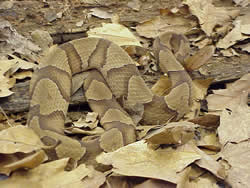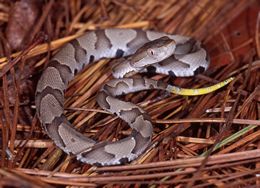Spring is almost over, it’s nice and warm and lots of animals have made an appearance. We often see the gray fox and groundhogs here at the museum. One animal that’s had a lot of sightings lately is the copperhead snake. I know a lot of people freak out when they hear about venomous snakes in the area. But they are here, they live in North Carolina and are abundant in our area. People’s first response it to kill a copperhead or even any other snake for that matter. I wanted to talk a little about why you shouldn’t kill them.

From the article Snakes: Nature’s Beneficial Ally–The Role of Snake
- Snakes play a beneficial role in helping to control rodent populations. Rodents can carry diseases and parasites that can be spread to humans. Left unchecked, rodents can destroy crops and invade homes in search of food. Rodents have been the culprits in several past plagues that have killed thousands.
- A snake in the garden helps deter unwanted visitors such as rabbits and birds, and some snakes, like the nonvenomous king snake, even eat venomous snakes such as cottonmouths and rattlesnakes.
- Don’t fear the snake, but do respect it. Nature has a purpose for the remarkable snake
In general if you leave them alone, they will leave you alone. Most people are bitten when trying to kill or handle these snakes. Copperheads are not aggressive reptiles. They are venomous but their bite is not often fatal.
Copperheads can be found in most habitats, typically by streams or places with lots of vegetation. They can be found in wood piles in the backyard and here is where you should be careful. Here is some advice to discourage snakes from your backyard-from the article: Rat Snake or Copperhead, How to tell the Difference
- The best way to discourage snakes from being close to your home is to get rid of habitat and food supply as much as possible. Store wood at least 18 inches off the ground. Keep the rodent population down by use of traps. Other than that there is really no good way to do it so it becomes important to teach your children to be cautious around any snake they see and to move away from it as quickly as they can. Use gloves and boots when working with brush and woodpiles, and be alert for movement. Snakes will normally avoid human contact.
- Apparently marigolds are natural deterrents for snakes so you might think about planting them around areas that you would like the snakes to stay away from.
- By allowing snakes to share your environment you can benefit from the natural pest control they provide.

Snakes are pretty awesome animals if you take the time to learn about them. It’s important to educate yourself about the venomous and non-venomous species in your area. I wouldn’t recommend killing any snake- either you are killing an innocuous non-venomous snake or you are putting yourself in danger by interacting with a venomous species.
good to know thank you
Hello, I’m researching snake bite photos for a new National Geographic series airing this September. I’m interested in the hemotoxic snake bite photo (from a Copperhead?) Do you know who shot the photo and how I could license it for broadcast? Thanks, Ross